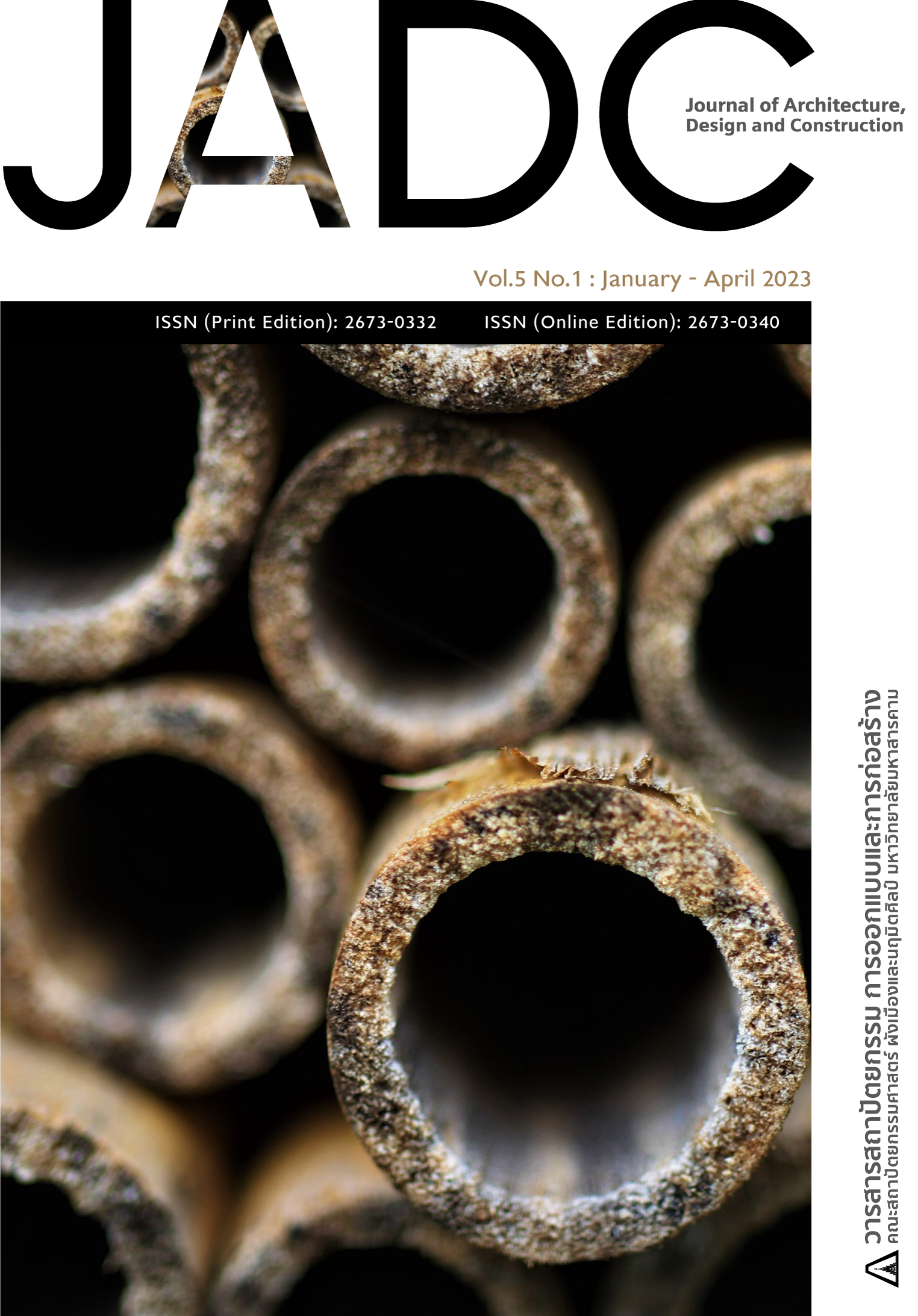ผลกระทบของจุดเชื่อมต่อกับการรับแรงของโครงข้อหมุนไม้ไผ่
Main Article Content
บทคัดย่อ
งานวิจัยนี้ได้ศึกษาการรับแรงของจุดเชื่อมต่อแบบต่าง ๆ ในโครงทรัชไม้ไผ่ โดยเลือกใช้ไม้ไผ่เลี้ยงมาประกอบโครงสร้างแบบโฮว์ทรัช ให้น้ำหนักจริงด้วยปั๊มมือจนเกิดการวิบัติและเปรียบเทียบผลจากการทดลองกับผลทางทฤษฎีโครงสร้าง โดยมีจุดต่อทั้งหมด 5 แบบคือ แบบแผ่นประกับไม้อัดคู่ยึดด้วยสลักไม้ไผ่, แบบแผ่นประกับไม้อัดคู่ยึดด้วยสลักเกลียว, แบบแผ่นประกับไม้อัดเดี่ยวยึดด้วยสลักเกลียว, แบบแผ่นประกับไม้อัดเดี่ยวยึดด้วยสลักเกลียวเสริมด้วยปูนนอนชริ้งค์ และแบบแผ่นเหล็กรูเอนกประสงค์ยึดด้วยสลักเกลียว จากผลการศึกษาพบว่าจุดต่อแบบแผ่นประกับไม้อัดคู่ยึดด้วยสลักเกลียวรับน้ำหนักได้สูงสุดเท่ากับ 1,912 kg แต่จุดต่อที่ดีที่สุดคือแบบแผ่นเหล็กรูเอนกประสงค์ยึดด้วยสลักเกลียวเนื่องจากทำให้องค์อาคารเกิดการวิบัติก่อนจุดต่อ เมื่อเปรียบเทียบระหว่างจุดต่อแต่ละประเภทพบว่าจุดต่อที่ใช้แผ่นประกับไม้อัดคู่จะรับน้ำหนักได้มากกว่าแผ่นประกับไม้อัดเดี่ยว 68% ส่วนอุปกรณ์ที่ใช้ยึดแผ่นประกับพบว่าสลักเกลียวจะช่วยให้การรับแรงได้มากกว่าสลักไม้ไผ่ 141% ส่วนการเสริมแรงด้วยปูนนอนชริ้งค์ เมื่อเทียบกับการไม่เสริมนั้นไม่มีความแตกต่างในการรับแรง เนื่องจากหน้าตัดของปูนนอนชริ้งค์ในลำไผ่มีน้อยมากและมีขนาดไม่เต็มหน้าตัดในการรับแรง เมื่อเปรียบเทียบผลในการทดลองกับทฤษฎีโครงสร้างพบว่าจุดต่อทั้ง 5 แบบยังไม่สามารถเชื่อมต่อองค์อาคารได้เท่าที่ควรจะเป็น มีการยึดรั้งและส่งถ่ายแรงระหว่างองค์อาคารต่ำทำให้มีระยะการแอ่นตัวในการทดลองสูงกว่าระยะการแอ่นตัวในทางทฤษฎีถึง 4 เท่า
Downloads
Article Details

อนุญาตภายใต้เงื่อนไข Creative Commons Attribution-NonCommercial-NoDerivatives 4.0 International License.
บทความที่ได้รับการตีพิมพ์เป็นลิขสิทธิ์ของวารสารสถาปัตยกรรม การออกแบบและการก่อสร้าง คณะสถาปัตยกรรมศาสตร์ ผังเมืองและนฤมิตศิลป์ มหาวิทยาลัยมหาสารคาม
เอกสารอ้างอิง
บุญส่ง สมเพาะและคณะ. (2564). คุณสมบัติไม้ไผ่บางชนิดเพื่องานก่อสร้าง. [ออนไลน์]. ได้จาก: http://forprod.forest.go.th [สืบค้นเมื่อ วันที่ 15 พฤษภาคม 2564].
สำนักวิจัยการจัดการป่าไม้และผลิตป่าไม้. (2564). คลังความรู้รายงานวิจัย. [ออนไลน์]. ได้จาก:
http://forprod.forest.go.th/forprod/forprod2017/Knowledgebase/ [สืบค้นเมื่อ วันที่ 18
พฤษภาคม 2564].
American Society for Testing and Materials. ASTM C109-02 (2002) Standard test
method for compressive strength of hydraulic cement. U.S.
American Society for Testing and Materials. ASTM D638-14 (2014) Standard test
method for tensile properties of plastics. U.S.
Chandrasekaran, S. (2019). Advanced steel design of structures. Boca Raton: CRC
Press.
Hibbeler, R.C. (2007). Engineering mechanics static. Singapore: Pearson Education,Inc.
Hu, J. & Wang, K. (2014). Influence of cement fineness and water-to-cement ratio on
mortar early-age heat of hydration and set times. Construction and Building Materials, 50, 657–663.
Lao, H. (2021), Connections for Bamboo Structures: Proceedings of the 2nd International Conference on Geology, Mapping and Remote Sensing. IOP Conference Series:Earth and Environmental Science(EES), Zhanjiajie, China.
Masdar, A., Suhendro, B., Siswosukarto, S. & Sulistyo, D. (2014). Determinant of Critical
Distance of Bolt on Bamboo Connection. Jurnal Teknologi Sciences and enginnering, 69(6), 111–115.
Panyakapo, P. (2014). Cyclic pushover analysis procedure to estimate seismic
demands for buildings. Engineering Structure, 66, 10–23.
Paudel ,S.K. (2008), Engineered bamboo as a building material: Proceedings of the 1st International conference on modern bamboo structures. Taylor & Francis Group, London, UK.
Riki, J.T.B., Sotannde, O. A. and Oluwadare, A. O. (2019). Anatomical and chemical
properties of wood and their practical implications in pulp and paper production. Journal of Research in Forestry, Wildlife & Environment, 11(3), 358-368.
Seixas , M.A., Ripper , L.A., & Ghavami, K. (2014), Deployable bamboo structure for sustainable architecture: Proceedings of the International conference on Non-conventional Materials and Technologies . Pirassununga, Iac-Nocmat.
Vengala, J., Jagadeesh, H.N., & Pandey, C.N. (2008), Development of bamboo structure in India: Proceedings of the 1st International conference on modern bamboo structures (pp. 51-64). Taylor & Francis Group, London, UK.


